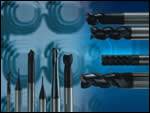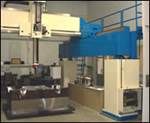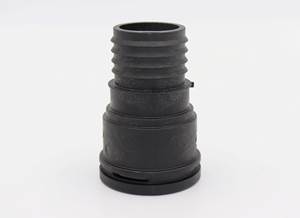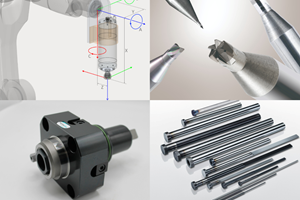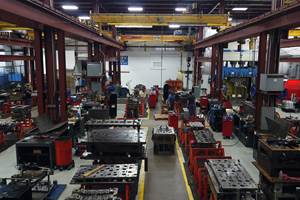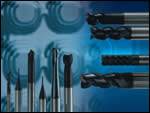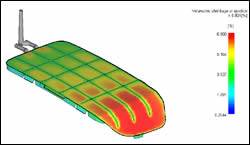Team Approach Is Key to Proper Inspection
Using a group rather than one person and changing the order of inspection is a win-win for this moldmaker—repeatable results with no rework.
In the quest to produce quality molds that will in turn produce quality parts, the proper inspection process can go a long way in ensuring a mold’s long-term success. One moldmaker recently changed its mold inspection philosophy by reversing the order in which it inspects and involving many rather than one, resulting in high quality parts the first time—without the need to rework a batch.
JK Molds Inc. (Upland, CA)—a manufacturer of high-volume, close-tolerance plastic injection molds specializing in the medical industry but also serving the home appliance, packaging, telecommunications, consumer products, electronics and healthcare industries—has customers ranging from custom part design firms to Fortune 500 companies at a global level.
Previously, this 35-man shop’s inspection method was performed the way most mold shops inspect: after the batch is created. But they found this method wasn’t working out for them. JK Molds President Patrick Elliott explains. “Traditionally in moldmaking, if you had 16 components, one department would run the first one and verify the setup, then run the 15 parts and inspect them afterwards. So you didn’t find out until the end if you had errors or had to rework anything.”
Most shops use gage balls during the inspection process, but JK Molds felt the results weren’t always repeatable. According to Elliott, the balls are usually a jig ground hole in a workpiece with a reference point customer-specific to each item. They needed a process that guaranteed repeatable results.
The Global Zero Point
After researching a number of inspection methods, JK Molds found a way to make gage balls work in their inspection process. This method relies on using the gage balls for inspection during the manufacturing process.
They discovered a system, which focuses on automated mold manufacturing. The Model ADP-MI (pronounced “adapt me”) precision gage balls1 work with pallet technology2.
Using the gage balls with either system further reduces setup times and eliminates dimensional inconsistency on angles (including compact angles) and radial forms—making even bigger strides to achieve quality. Additionally, the gage balls improve overall efficiency and facilitate communication between the engineering department and the shop floor.
Implementing this technology in the shop would allow JK Molds to achieve a global zero/global datum point between all setups in the shop, in which all dimensions and tolerances are referencing the same point in the manufacturing process—reducing setup time and checking time, and meeting the company’s goal of having its machines run as long as possible, notes JK Molds Managing Partner Jason Van Noy.
Bumps in the Road
Once Elliott and Van Noy realized the many advantages the gage balls afforded, it was time to get the rest of the shop on board. They named Jason Franzen, the head of their EDM department, the full-time inspector—and together the trio began the process of changing the company’s philosophy.
Elliott explains, “Almost everyone that is involved in manufacturing also is involved with inspection. We made all department heads responsible for inspecting at each manufacturing interval. We had shop meetings and some training to bring them up to speed on this. Each one of them has a designated inspector number that they mark on the process sheet that runs though the shop. This routing sheet follows every component through the shop and describes all of the operations that are going to happen on a component. Included is a description of what needs to be inspected and each department is responsible for that operation—at each component, not at a batch level.”
Van Noy adds that it took several months to bring the entire shop up to speed on this new inspection method as well as how to use all of the inspection instruments, with the exception of running the CMM, which requires specialized training and is run by Franzen. “There was a bit of a learning curve in the beginning,” Elliott recalls. “But we worked it out, and made sure we put in the extra time on our jobs so we wouldn’t fall behind.
“It was really a matter of changing the philosophy of how we were going to inspect,” he continues. “We changed the order of which things are inspected. Instead of waiting until each batch is completed and then inspecting it, we now run all operations on one part in a particular cell or area, and the results are inspected before the next part is worked on.
“In the beginning there was a little bit of hesitation because of the increased setup time, but it actually pays off in not having to rework components or causing delays in the manufacturing process down the line,” Elliott adds. The company has had several follow-up meetings to ensure everyone is on the same page—in addition to its weekly process improvement meetings with both the engineering and production departments to continually tweak the process.
Franzen notes that since the change has been implemented, accuracy has increased and setup time has decreased by at least 40 to 50 percent. Fortunately, the cost to the shop was minimal. Elliott says that JK already owned all of the inspection equipment except for the gage balls.
Goals Met
Initially, using the global zero point increased costs during setup and inspection, but Van Noy notes that it is still less than the cost of manufacturing an entire batch of components and then having to rework them. Now, it simplifies the entire inspection process.
“Everything is measured from the same zero point,” Elliott explains. “All of our engineering drawings reference the same global zero and the tooling balls can be put in the 3R to get their reference point. Then, the workpiece is placed in the 3R holder and the part can be inspected from that same zero.”
Elliott adds that a lot of the medical companies they work with are highly satisfied with the level of inspection JK Molds is performing, and the documentation the company provides its customers with gives them the confidence that they can achieve repeatable results, cavity to cavity.
These repeatable results also led to leadtime reductions of 25 percent—and Elliott is very grateful for that. “Going from the same datum each time—from the center of the gage ball—makes it easier for my guys to verify all of the numbers,” he states. “We now use the global zero point on all of our inspection and we are very satisfied with the results.”
1 Model ADP-MI precision gage balls from Len Graham Consulting.
2 Pallet technology from Erowa and System 3R.
Related Content
VIDEO: Maintaining a Customer-Centric Culture
Progressive Components President Glenn Starkey talks about the importance of the customer and culture when developing technology solutions for the moldmaking industry.
Read MoreHow to Harness 3D Scanning for Mold Tool Repairs
3D scanning supports the repair of molds with no history, drawings or design files.
Read MoreTechnology Roundup: New/Improved Technologies You Don't Want to Miss
With all the technology joining the market, moldmaking is a versatile, ever-evolving industry. As such, this technology roundup has no specific theme — it features a variety of products for applications and solutions across the industry.
Read MoreIndiana Mold Builder Decatur Mold Offers a History of Grit and a Future of Innovation
Decatur Mold Tool and Engineering Inc. serves as a tooling tour guide, helping busy tooling managers reduce uncertainty, lighten workload.
Read MoreRead Next
The Center of Automation
Macro pallet-mounted gage balls reduce overall costs in electrode machining/manufacturing and reduce leadtime by 25 percent.
Read MoreComplete Mold Filling Analysis Helps with Automotive Design Challenges
Intier Automotive relies on CAE consulting for automotive design and innovation.
Read MoreThe Benefits of a Remanufactured CMM in Your Shop
The only way to economically meet the need for a large gantry CMM with an uncommon measuring envelope was to find an existing one, rebuild it and remanufacture it.
Read More
